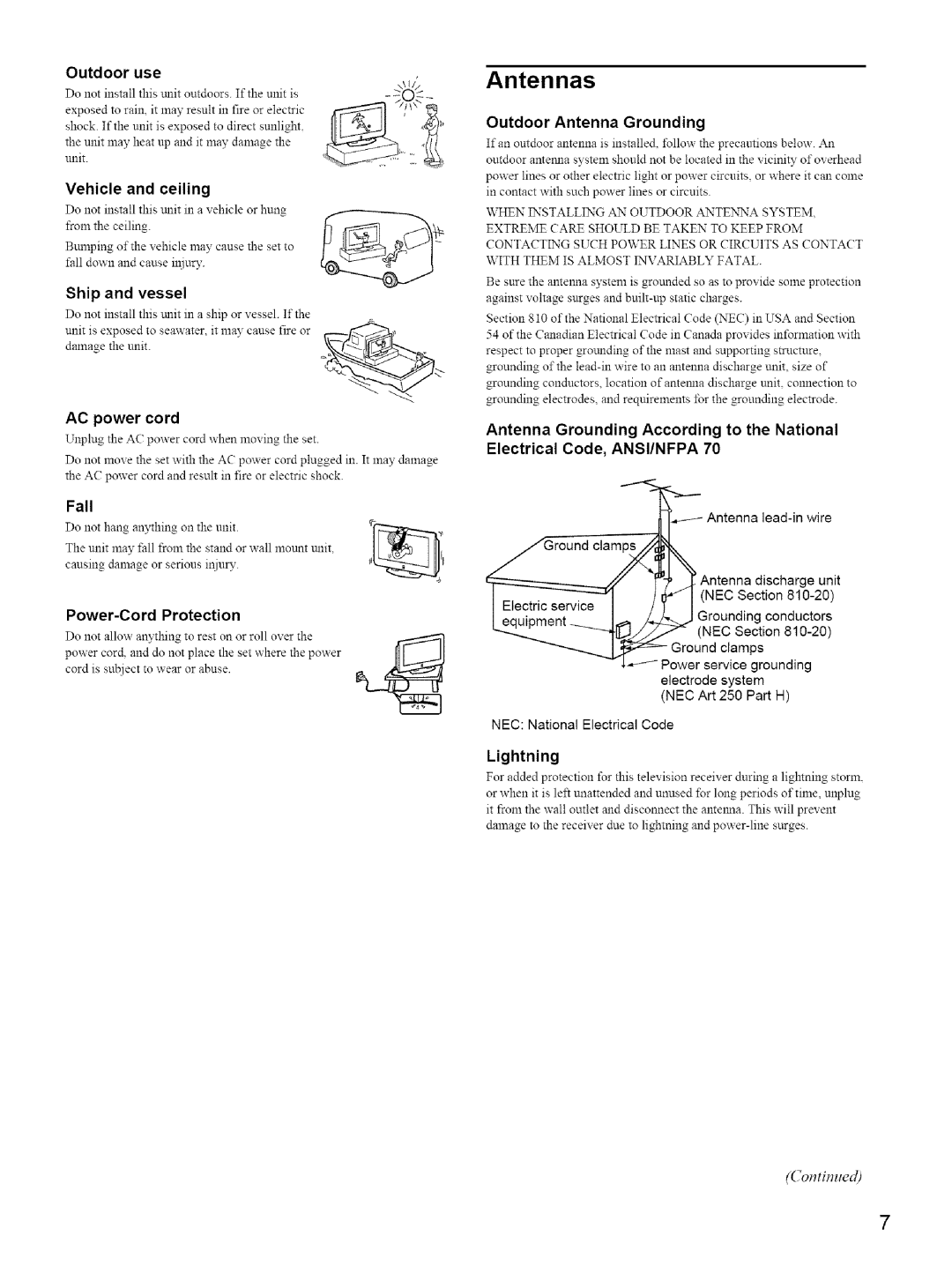Operating Instructions
EGA
Contacting Sony
Owners Record
Important Notice
Safety
Cleaning
Power Sources
For the set with a polarized AC power cord plug
Wiring
Damage requiring service
For the set with a three-wire grounding type AC plug
AC power cord
Accessories
Protruding location
Installation
Optional accessories
Carry the TV in the specified manner
Outdoor Antenna Grounding
Power-Cord Protection
Outdoor use
Ship and vessel
Servicing
Service
Replacement Parts
Safety Check
Watching
Installing the TV
Additional Information
Using Advanced Features
When you unpack this unit, make sure it includes Following
Overview of the Remote Control
Unpacking
Sony
Remote Control Descriptions
Reset PIC OFF Power Display Sleep
Programming the Remote Control
Changer
Manufacturers Codes
Satellite Receiver
Operating a satellite receiver
Using Your Remote Controls with
Other Equipment
Operating Cable Box
Operating a DVD 5.1 Channel Sony DAV
Operating a DVD player or DVD Changer
Front Panel Controls and Connectors
Overview of the TV Controls and Connectors
To open the drop-down panel
Lmono
Rear Panel Connectors
Preventing the TV from Falling Down
Cable box connections
Basic Connections Connecting Cable or an Antenna
Connector types
Connecting directly to cable or an antenna
Connecting the Power Cord
Connecting Optional Equipment
Connect the other plug of the power cord to a wall outlet
VCR
Connecting a VCR and Cable TV
Disconnect all power sources before making any connections
Connecting a Satellite Receiver
Udioir
Connecting a Satellite Receiver and a VCR
When using your audio system speakers
Connecting an Audio Receiver
AUDIO-L
Connecting a DVD Player with Component Video Connectors
AUDIO-L
Connecting a DVD Player with S Video and Audio Connectors
+,,,!Jl
Connecting a Digital Cable Box
Connecting a Digital Satellite Receiver
Connecting a Digital Satellite Receiver with Hdmi Connector
Page
II-NaCENTERISPEAKER-d
When using the TVs speakers as the center speaker
Connecting a Camcorder
To perform Auto Program again
Setting the TV
Setting the Channels
To cancel Auto Program
Tip
To watch VHF/UHF channels with an antenna
To fix in a TV channel
Using the Menu
Iii%
You can select the language to be displayed in all menus
To adjust the setting
Selecting the On-screen Menu Language
To open the menu screen and select Option
Press Menu
Watching the TV
Adjust the volume using the VOL +/- buttons
Other button Operations
Press tt/ to select Setup, then press @
Offers this service
Watching with closed caption
Picture
Selecting the Picture Mode
Press t,/4 to select TruSurround, then press
Selecting the Effect Mode
Press t,/4 to select Audio, then press @
Press 4/11,to select Effect, then press @
Changing the Wide Screen Mode
Using the Wide Screen Mode
Wide
Press 4,/11,to select Screen, then press
Using the menu
Press 4,/!!, to select the desired screen mode, then press
Default
Wide Screen Mode options available in the Screen menu
Call
Using the Freeze Using the Picture Off Function
Setting the Center Speaker Mode
Using the Center Speaker Feature
To return to the normal speaker mode
@ @ @
Listening to the center speaker sound from the TVs speakers
Press 4,/ to select Phase then press
Adjusting the phase of the sound
Press t1,/€ to select Audio, then press
Press TV, any of 0-9 and ENT enter or CH +
Setting the Video Inputs
Press Video Video 4* indication appears
To return to watching the TV
Press t,/ to select Setup, then press
Using the Video Label and Skip Feature
Setting your favorite channels
Using Favorite Channels
Watching favorite channels
Using the Channel Label Feature
Press 4,/11,to select Channel, then press %¸ Reoo
Adjusting the Picture Position Vertically
Press /II, to select Screen, then Press @
Adjusting the Picture Position Horizontally
Press t,/II, to select Video, then press
Adjusting the Picture Quality
Press II, to Select Picture Then press @
Selective
To reset to the factory settings
Press Tl,//4./, to make the desired Adjustment Then Press @
Adjusting the Sound Quality
Selective options
Selecting Stereo or Bilingual Programs
You can enjoy stereo, bilingual and mono programs
Selecting stereo or bilingual programs using the menu
Selecting How to Control the Volume TVsSpeakers
Press To select the desired Reception Then
Press tl,/ to select Audio Out, then press
Press t1/ to select Audio, then press
Press 4,/ to select the desired option, then press
Press tl,/ to select the desired option, then press
Using the Parental
Control Feature
Press tl,/ to select Audio, then
Press 4,/11,to select Select Country, then press
Press /II, to select @, Parent, then press
Set Lock to Off in the Parent menu
To deactivate the Parental Control feature
Selecting a Custom Rating
2o,,o
English Rating
Sonys predetermined ratings
What the Ratings Mean
Ratings in the U.S.A
To block programs or movies broadcast Without a rating
TV ratings
Movie ratings
Ratings in Canada
Canadian English Language ratings
Using the Screen Saver Function
Automatically
Turning Off the TV
To cancel the Sleep timer
Trouble Symptoms Remedies
Troubleshooting
Self-diagnosis function
Problem
Specifications
Index
Default
Printed on 100% recycled paper

